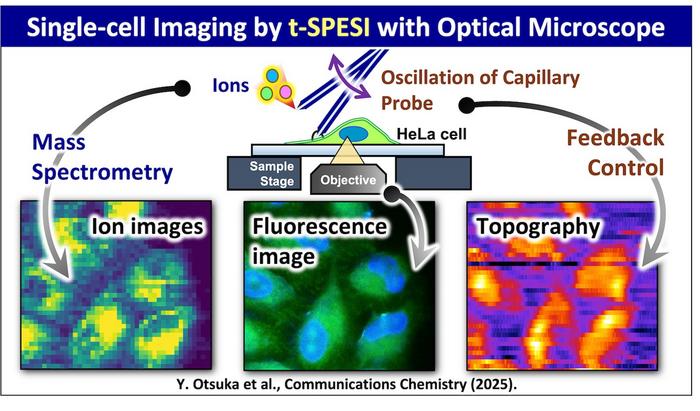In an extraordinary leap forward for cellular biology and disease research, scientists at The University of Osaka in Japan have unveiled an innovative technology that allows for the unprecedented visualization of molecular distributions within individual cells. This cutting-edge advancement, which harnesses tapping-mode scanning probe electrospray ionization (t-SPESI), promises to transform our comprehension of cellular heterogeneity and the intricate biochemical landscapes that define tissue samples. The pioneering work, recently published in Communications Chemistry, opens new avenues for detecting and analyzing the diverse cellular components that play pivotal roles in health and disease.
Tissue samples are notoriously complex, comprised of varied populations of cells intricately interwoven with distinct molecular compositions. Traditional biochemical techniques often obscure this complexity by averaging molecular data across numerous cells, blurring essential details critical for understanding pathological mechanisms. The Osaka team’s approach circumvents these limitations by enabling analyses at the single-cell level, revealing the molecular heterogeneity that underpins cellular function and dysfunction.
At the heart of this breakthrough lies t-SPESI, a technique that couples a finely controlled scanning probe with electrospray ionization to enable spatially resolved sampling of molecular species. Unlike conventional mass spectrometry imaging methods that often lack the spatial resolution to isolate subcellular regions, t-SPESI works by delicately tapping the probe onto targeted regions of a cell’s surface. This process extracts minute molecular samples with high spatial precision, which are then subjected to mass spectrometric analysis to identify and quantify the chemical constituents with accuracy.
A key innovation presented by the researchers is the development of a novel t-SPESI apparatus that integrates seamlessly with an inverted fluorescence microscope. This design advancement allows real-time visualization of the sampling process, providing unprecedented insight into how and where molecular data are collected. By observing the microscopic sample simultaneously in multiple imaging modes, researchers can correlate fluorescence-tagged molecular distributions with mass spectrometry data, creating a comprehensive multimodal portrait of cellular architecture and chemistry.
The multimodal nature of this system is particularly transformative. It can detect fluorescently labeled biomolecules, discern the topography of the cell surface, and map the molecular species inside the cell through mass spectrometric imaging. This rich dataset provides a three-dimensional window into cellular heterogeneity, revealing how chemical gradients, membrane structures, and metabolic activities vary within and between individual cells.
One of the initial demonstrations of this approach involved the visualization of lipid distributions within HeLa cells, a widely used human cell line in biomedical research. Lipids, crucial components of cellular membranes and signaling pathways, are known to exhibit diverse behaviors linked to metabolic health and disease processes. By mapping the intracellular localization of lipids, the researchers could directly observe variations in membrane composition and lipid metabolism at the single-cell level — insights that are often lost in bulk analyses.
The precision of this technology enabled distinctions between different cell types based on their unique lipid profiles and surface morphology. These findings herald a future where detailed molecular fingerprints of diseased versus healthy cells can be discerned within complex tissues, an advancement that bears significant implications for diagnostics and therapeutics. The ability to visualize such multidimensional molecular information offers a powerful tool for unraveling the molecular underpinnings of diseases such as cancer, neurodegeneration, and metabolic disorders.
The integration of mass spectrometry with fluorescence microscopy in the t-SPESI system also provides a pathway to link molecular distributions with cellular phenotypes, a vital step towards understanding the heterogeneity in cell populations. As diseases often arise from subtle changes in cellular composition and function, this technology could enable researchers to detect early molecular signs of pathology before morphological symptoms become apparent.
Beyond basic research, the implications for precision medicine are considerable. By enabling single-cell analysis in complex tissue samples, the technology may facilitate the identification of subpopulations of cells that respond differently to treatments, enabling more targeted and effective therapeutic interventions. Moreover, the detailed mapping of metabolic and signaling molecules within single cells could lead to the discovery of new biomarkers for disease progression and treatment response.
The method’s adaptability to various sample types and fluorescent labeling strategies also renders it a versatile platform for studying diverse biological questions. From tracking lipid metabolism in cancer cells to exploring neuronal signaling pathways, t-SPESI’s capacity to generate multidimensional molecular data sets a new standard for cellular imaging technologies.
Lead author Yoichi Otsuka emphasized the unit’s capability to observe the micro-sampling simultaneously, providing a unique window into the interactive molecular environment of cells. Equally, senior author Michisato Toyoda highlighted the system’s capacity to simultaneously visualize lipids, fluorescence signals, and topographic features, underlining its multifaceted analytical power.
In sum, this innovative merging of microscopy and mass spectrometry embodies a significant stride toward unraveling the complex molecular tapestry of cellular life. The resultant granular understanding of single-cell molecular landscapes promises to illuminate the mechanisms of disease with unprecedented clarity, fostering future breakthroughs in diagnostics, drug development, and therapeutic strategies. As the technology matures and becomes more widely adopted, its impact on precision medicine and biomedicine at large is poised to be profound.
Subject of Research: Cells
Article Title: Single-Cell Mass Spectrometry Imaging of Lipids in HeLa Cells via Tapping-Mode Scanning Probe Electrospray Ionization
News Publication Date: 14-May-2025
Web References: http://dx.doi.org/10.1038/s42004-025-01521-2
References: “Single-Cell Mass Spectrometry Imaging of Lipids in HeLa Cells via Tapping-Mode Scanning Probe Electrospray Ionization,” Communications Chemistry, DOI: 10.1038/s42004-025-01521-2
Image Credits: Yoichi Otsuka
Keywords: Electrospray ionization, Lipid metabolism, Lipids, Membrane lipids, Metabolic health, Single cell profiling, Single cells, Spectroscopy, Imaging analysis
Tags: biochemical landscape explorationcellular biology researchcellular heterogeneity studieshealth and disease molecular componentsinnovative biomedical research methodsmass spectrometry imaging advancementsmolecular visualization techniquespathology and molecular mechanismsscanning probe electrospray ionizationsingle-cell analysis technologytissue sample complexityUniversity of Osaka scientific breakthroughs





